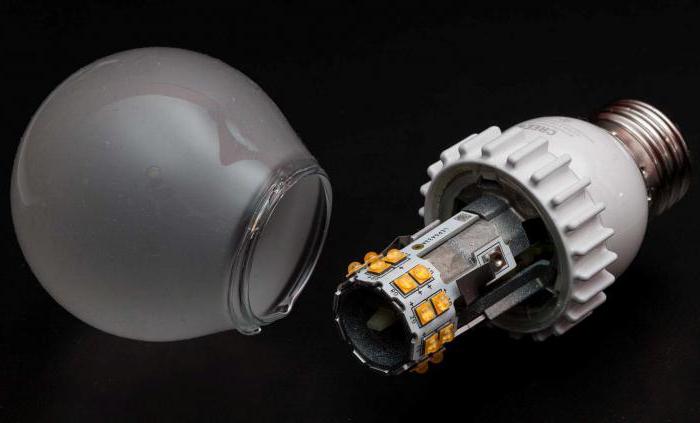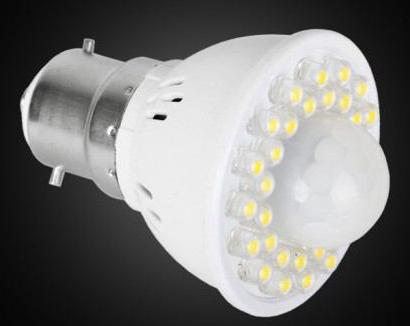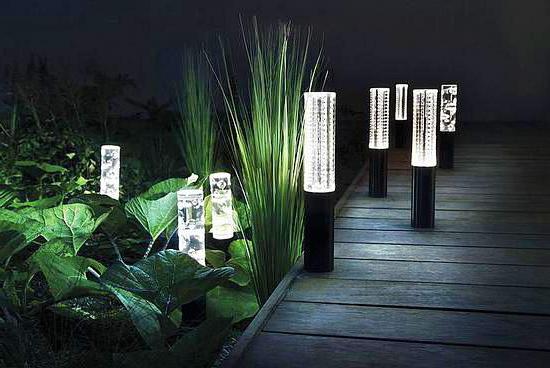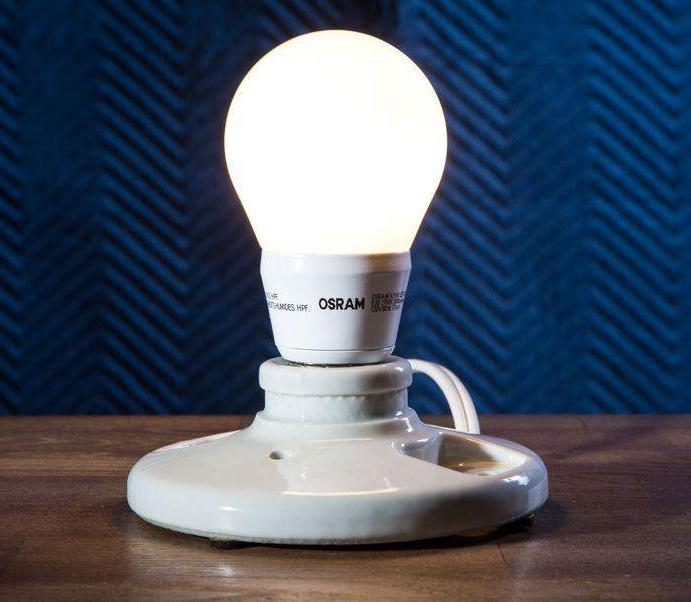LED bulbs: advantages and disadvantages of use
LED lamps for several years noware positioned on the market as the most modern devices for organizing lighting. Progressive LED technology finds its place in the industry, in providing public buildings and, of course, is widely used in private homes. The popularity of such devices is promoted by aggressive advertising, in which manufacturers list their numerous virtues. However, in some parameters and performance, LED bulbs are still inferior to traditional lighting. Even incandescent lamps in some cases are more attractive solution.

Features of LED-lighting
LED lamps of standard formatare a complex construction, including several functional elements. It can be radiators, capacitors and even radiation-controlling drivers. By themselves, LED bulbs for 220V consist of three components - a diffuser, a chip and a printed circuit board.
The diffuser is the simplest element of construction,which is performed in the form of a hemisphere, serves to increase the angle of directionality of the light flux. As for the material for the diffusers, they are usually made of polycarbonate or other types of transparent plastic. LED chip can be called a source of radiation. One device can have from one to hundreds of such elements. But more often than not, LED-bulbs for home contain not more than a dozen chips. Thanks to the printed circuit board, the structure does not heat up. Its aluminum base removes heat to the radiator, which ensures safety when operating such devices.

Types of devices
Classifications of LED devices are quitea lot of. First of all, it is worth highlighting the difference in power bulbs - this range is from 1 to 7 watts. Like halogen devices, LED-models can be powered from both the 220 V network and from the controllers with a low voltage of 12 V. The lamps differ also in the type of cartridge. Manufacturers produce devices designed for baseboards of E14, GU10 and MR16 formats. The most common LED-bulbs E27, which just support advanced management capabilities through an integrated driver. To a special category can be attributed ceiling lamp models. They are calculated specifically for installation in suspended structures with point placement.
Advantages of LED lamps

Marketing campaigns that promoteLED lighting, of course, can exaggerate the advantages of this lighting technology, but in most cases, positive positioning has real grounds. So, LED-devices have the following advantages:
- Low energy consumption. In comparison with the usual lamps, the savings can reach 20-30%.
- Durability. The average service life is 40-50 thousand hours.
- Ecological compatibility. If you break the LED-light bulb, it will not emit dangerous to human fumes.
- Aesthetic appearance. The absence of massive radiating elements opens up wide possibilities for manufacturers to experiment with cases, which causes a variety of design solutions.
- Security. In addition to environmental safety, it is worthunderline the minimum risk of fire due to thermal contact with closely spaced surfaces. Again, due to the specificity of the internal device, the diffusing bulb does not heat up.
Disadvantages of LED lamps

Significant advantages still could not make LED technology indispensable and universal in all areas. This was hampered by the following shortcomings:
- Unnatural color spectrum. This is an ambiguous parameter of LED lamps, butMany users view the nature of the glow as their weak point. Spectra can vary, but most often the lamps emit either dazzling white or yellow light. In this there is a plus in terms of the quality of lighting, but for the eyes such a ray is tiring.
- Constructional shortcomings. This applies to models with flat surfaces. As a rule, such LED-bulbs have a narrow angle of dispersion - 120 degrees.
- The complexity of the installation. To implement a full-fledged LED lighting system with the ability to monitor parameters, a large number of electrical operations are required.
- The risk of buying a fake. You can count on the advantages of LED-devices only in the case of buying a quality copy, which is also not easy.
How much are LED bulbs
Actually, the high cost and causeswide distribution of low-quality counterfeits. Initially, experts recommend to focus strictly on the products of OSRAM and Philips. These companies offer standard household lamps with price tags ranging from 500 to 1000 rubles. But this is not the limit - large lamps can be sold for 3-4 thousand. Also there is a wide segment of budget LED light bulbs, in which you can run into a fake. Typically, such models are produced by little-known manufacturers, asking for a lamp of about 200-300 rubles. Devices of a similar price level are offered by many domestic manufacturers using the elemental base of the same OSRAM and Philips brands. But, of course, the operational properties in this case will be far from those that promise in the advertising booklets.

Conclusion
Apparently, the expediency of transition toLED technology is not yet so obvious. On the one hand, an unnatural and tiring light, to which office workers complain, can scare off. And on the other - high cost does not allow large enterprises to re-equip their lighting communications. And yet the popularity of LED bulbs at 220V is steadily rising. This choice is made for various reasons. Ordinary homeowners value in LED-based devices reliability, durability and original design. Utilities update the old lamps to LEDs due to low energy costs. Still, large floodlights in the complex lighting of objects often form the first lines in the cost of electricity, so even a small percentage of minimizing consumption provides significant savings.
</ p>




